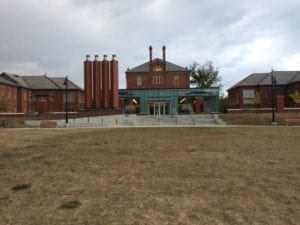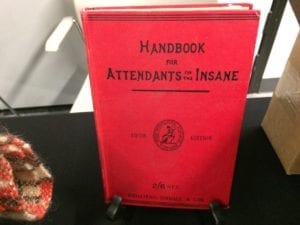Well-received, well-attended Mental Health Film Series Premiere at Humber College Lakeshore
I much enjoyed the “Keys to Our Past” Mental Health Film Series Premiere that took place at the “G” Building at Humber College Lakeshore on the evening of Oct. 4, 2017.
I’ve outlined what the series is about at a previous post:
Each of the series of films that we saw was between about seven and 11 minutes in length.

I much enjoyed the journey from the “L” Building to the “G” Building (above). This is a view looking toward the east. Jaan Pill photo
The topics covered were (as the poster on the right, which you can enlarge by clicking on it, notes):
- Asylums
- Moral Treatment
- Somatic Therapy
- Drug Therapy
- NCR (Not Criminally Responsible)
- Language & Stigma

A display table featured several items related to the positioning of mental illness in years gone by. The book in the photo was published in 1908. Jaan Pill photo
Four individuals, from different places (York University, Yorkville University, Waypoint Centre for Mental Health Care, and Lakeshore Grounds Interpretive Centre) took turns introducing each of the short segments, and engaged in a Q & A with the assembled audience.
Said individuals were:
- Rachel Gerow (student at Yorkville University)
- Gary Bold (student at York University)
- Laura Ball (Staff person at Waypoint Centre for Mental Health Care)
- Jennifer Bazar (Curator, Lakeshore Grounds Interpretative Centre)
The artist who created the superb and effective chalkboards is Nick West, a staff member at Waypoint.

The display table, at the film event, included an electroshock device, which dates as I understand from the 1960s. The device at the left is a surgical instrument that was used for “Somatic Therapy” brain operations in years past. Jaan Pill photo
Each of the above-noted individuals has performed a highly impressive and valuable role, as a key player in the creation of this excellent series of films, which address mental health issues in a manner that is accessible, and in a way that closely commands the attention of the viewer.
First task: Locate the “G” Building at Humber College
The event was held at the “G” Building.
I have a less than perfect sense of direction.
The part of my brain that deals with spatial perception is out of whack, meaning that I often guess about where I’m supposed to be headed, and get lost along the way. In this case, we headed straight for the “L” Building, at the Humber Lakeshore Campus. I was convinced in my mind that the “L” Building was the “G” Building, but a close inspection of the signage enabled the fact to quickly dawn, upon me, that I was mistaken in my guesswork.
Fortunately, we asked a Humber student, who indicated that the “G” building was directly to the east of the “L” building, which meant that an easy walk across an open quadrangle brought us to our intended destination.

Humber College Lakeshore, Oct. 4, 2017. This is a view looking south toward lake Ontario. Jaan Pill photo
Getting lost, while inconvenient, never bothers me, given that there’s always something new to be learned in the process.
Now, if somebody depends upon me for directions, however, that is another story, of course.
“G” Building a great venue for watching videos
A neat feature of the “G” building is that a new addition has been built on the west side of the building, and that is where the screenings were held. The original building dates from the late 1800s. The building-addition was a great venue for watching the Mental Health Film Series Premiere at Humber College.

Humber College Lakeshore, Oct. 4, 2017. This is a view looking north, from just outside the “G” Building. Jaan Pill photo
Great format for sharing information
As well as having a less than perfect sense of direction, I also find it nearly impossible to sit still to watch a film of any length. For that reason, I almost never watch television, and I seldom sit for 90 minutes to watch a movie in a theatre. My favourite way to watch a movie is to set it up as a DVD on my laptop.
I’ll watch 10 minutes at a time, then pause it, go do something else, and then return to watch another 10 minutes.
Fortunately, I’ve been following research indicating that sitting still for more then 10 minutes or so at a time is going to wreck your body, and destroy your once-outstanding good health, so by happenstance, things have worked out well for me, so far as sitting goes.

As we were watching the videos, occasionally Air Traffic Noise made its presence known. If you look closely, you will see an aircraft in the sky in this image. You can click on the photo to enlarge it. This applies to all the photos. Jaan Pill photo
I mention this because the format for the Mental Health Film Series Premiere was absolutely perfect, for my particular tastes, and as it turned out, for the tastes of other people who attended the screening. I did sit still, but with the short film segments, in each case interspersed with an audience Q & A, the time went quickly and I did not get restless.
Asylums
We began by watching a short clip about asylums – with a particular focus on the role that architecture and setting has on a person’s mood.
The narration was by John Leclair, who in this project plays the role of Actor, Writer, & Creative. He plays this role really well! In each 10-minute clip, he goes through the same introductory routine. You have to see this series yourself. John Leclair is perfect for this role! Really impressive! Great role play!
Moral Treatment
I’ve lost track of how many videos there were, that were screened. I do know that Moral Treatment was covered as a concept. In times past, Moral Treatment (the concept) was expressed in the decision-making process involved in the choice of the physical setting (often in a natural setting, near water) where asylums were built. It was also expressed on determining the views out of windows, and even the circulation of air in buildings.
What a great way to approach urban design!
Somatic Therapy
The clip about Somatic Therapy highlighted attempts, in years past, to try to make things better for the mind by doing things to the body.
Drug Therapy
Among other things, this clip dealt in a cogent way with psychedelic drugs, as viewed in medicinal and recreational contexts.
The Q & A following this video was wide-ranging and of much interest, as were the Q & As (and commentaries from varied sources) for the other clips.
NCR (Not Criminally Responsible)
The history of how the concept of Not Criminally Responsible originated, and how it evolved in response to public pressures, was covered in another focused, brief video clip, bookended by the same introduction and ending, played with flair and energy by John Leclair, who as I have already said, is superbly suited for the role at hand.
Even the lighting for John Leclair, as he sits in his “studio,” is perfect – a little harsh, a little strong, accentuating every feature of his face.
It’s like “film noir” lighting, but without the harsh contrasts. The entire film set is pretty evenly lit. The lighting works perfectly!
If I recall correctly, this segment dealt with the value of evidence-based policy. This is such an important point – the value of evidence! I am very pleased that evidence was highlighted in this film series.
Language & Stigma
This area was also covered well. We must take care how we use language.
Conclusion
I highly recommend this Mental Health Film Series. If you have an opportunity to view these short films, you will learn a great amount of accurate, balanced information about what mental illness is, and what it isn’t.
Among other things, you will have the opportunity to think about the history of architecture, treatment options for mental illness, and a wide range of other topics that have a relationship to mental well-being and mental health in Canada.



Leave a Reply
Want to join the discussion?Feel free to contribute!